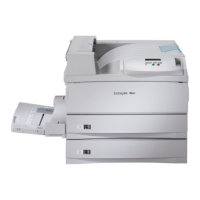PCL
2-51
ESC
*b#M
0 Uncoded (Default)
1 Run-Length Encoded
2 Tagged Image File Format (TIFF)
byte
3DeltaRow
5 Adaptive Compression
9 Replacement Delta Row
1002 Group 4
1003 Group 3 one dimensional
1004 Group 3 two dimensional K=2
1005 Group 3 two dimensional K=4
1006 TIFF word (16 bit)
1007 TIFF double-word (32 bit)
1008 Adaptive compression (includes TIFF
word and TIFF double-word)
Set Raster Compression Mode
Identifies the compression mode the host uses to transfer RIG data.
For instance, this command can be run-length encoding or TIFF
encoding.
Note: For further information, see “Raster Compression Mode” on
page 2-60 and “Group 3 and Group 4 Raster Compression” on
page 2-65.
ESC
*b#W[data]
# = Number of Data Bytes
Transfer Raster Data by Row/Block
Transfers RIG data.
Note: After each command, the cursor position is moved to the
beginning of the next raster row.
ESC
*rB End Raster Graphics (Version B)
Signals end of raster graphics transfer. If a Raster Height is
specified, the cursor is moved to the first raster row past the Raster
Height.
ESC
*rC End Raster Graphics (Version C)
Same as Version B, but:
• Resets compression mode to uncoded.
• Sets left graphics margin to 0.
ESC
*t#H Raster Width (Destination)
Sets the width of the destination raster.
ESC
*t#V Raster Height (Destination)
Sets the height of the destination raster.
Table 2-31: Raster Graphics (Continued)
Command / Parameters Function / Result

